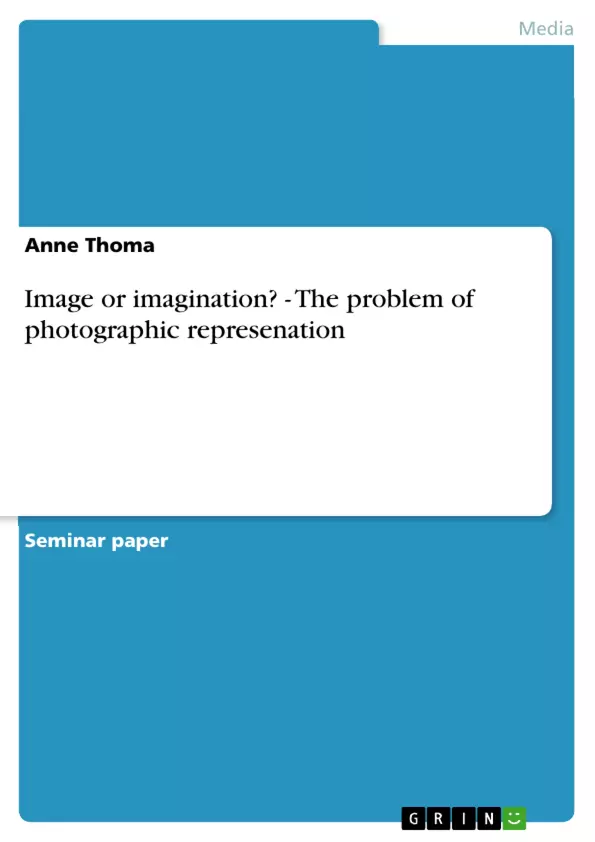Altered pictures have always caused much controversy. Even when photography was still in its infancy, manipulative arrangement was already an issue. Nowadays, digital photography in particular faces an erosion of trust because newsmagazines and newspapers make frequent use of various manipulation techniques, which fiercely challenges the shared belief that photographs record the world objectively and truthfully. Oddly enough, even though a picture may ′lie′, it is still used as evidence in the courtroom or understood as a valuable historical document.
In my analysis of photography′s oscillation between image and imagination, with the two terms representing something traditionally thought of as real on the one hand and something thought of as constructed on the other hand, I want to address these questions and analyse how and what a picture represents. I argue that meaning is to a large extent constructed by the viewer and does not exist as an inherent quality. Consequently, whether an altered picture is seen as fraud or merely as an optimisation is a very subjective matter and strongly depends on contextual information. The viewer′s judgement is influenced by the path through which the image is mediated and the context in which it is embedded, but his judgement is also dependent on what the image means to him, not only on what he sees in it. This is not to say that photographs can under no circumstances be used as evidence. However, what can be said is that their truth-value is often overestimated. In any case, manipulation is not a side-effect that coincided with the birth of digital photography. Selection, framing, and other adjustments have always played an important role in film photography.
After a general introduction to the basic principles of representation and their development up to the present point of time, I will continue with a brief history of photographic practices and analyse how issues of photographic realism were dealt with in the nineteenth and early twentieth centuries. I will then turn to what is often called "the myth of photographic truth" and analyse the role of representation in both traditional and digital photography. The last chapter will also broach the role of ideology.
In short, I want to argue that photography is capable of meaning, or representing, more than one thing, that it consists of a network of signs and operates both on the basis of predefined structures and personal input.
Inhaltsverzeichnis (Table of Contents)
- Introduction
- Representation: Man's access to the world
- Photography: A brief history of its practices and discourses
- Photographic representation: Reflections on the myth of photographic truth
- Conclusion
Zielsetzung und Themenschwerpunkte (Objectives and Key Themes)
This paper explores the complexities of photographic representation, examining how images are constructed and interpreted. It investigates the relationship between image and imagination, questioning whether photographs capture reality or create their own meaning.
- The nature of representation and its impact on our understanding of the world.
- The history of photographic practices and the evolution of discourses surrounding photographic realism.
- The myth of photographic truth and the role of ideology in shaping our perception of images.
- The relationship between photography, fine art, and technical process.
- The subjective interpretation of images and the influence of contextual information on meaning-making.
Zusammenfassung der Kapitel (Chapter Summaries)
- Introduction: This chapter introduces the central problem of photographic representation by analyzing the manipulation of O.J. Simpson's mug shot in a news magazine, highlighting the potential for images to be manipulated and interpreted subjectively. It establishes the importance of understanding the interplay between image and imagination in shaping meaning.
- Representation: Man's access to the world: This chapter delves into the fundamental principles of representation, discussing how we access and understand the world through images. It explores the relationship between the objective world and the subjective interpretation of representation, raising questions about the potential for images to distort reality.
- Photography: A brief history of its practices and discourses: This chapter provides a brief overview of the history of photographic practices, tracing the evolution of photographic realism and its associated discourses from the nineteenth century to the early twentieth century. It examines how different eras and cultural contexts have shaped our understanding of the photographic image.
Schlüsselwörter (Keywords)
This paper focuses on key concepts such as representation, photographic truth, manipulation, ideology, and contextual interpretation. It explores the role of photography in shaping our understanding of reality and the complex interplay between images and imagination in creating meaning.
- Citation du texte
- Anne Thoma (Auteur), 2006, Image or imagination? - The problem of photographic represenation, Munich, GRIN Verlag, https://www.grin.com/document/58539



